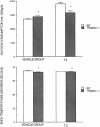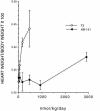Selective thyroid hormone receptor-beta activation: a strategy for reduction of weight, cholesterol, and lipoprotein (a) with reduced cardiovascular liability
- PMID: 12888625
- PMCID: PMC187768
- DOI: 10.1073/pnas.1633737100
Selective thyroid hormone receptor-beta activation: a strategy for reduction of weight, cholesterol, and lipoprotein (a) with reduced cardiovascular liability
Abstract
Few treatments for obesity exist and, whereas efficacious therapeutics for hyperlipidemia are available, further improvements are desirable. Thyroid hormone receptors (TRs) regulate both body weight and cholesterol levels. However, thyroid hormones also have deleterious effects, particularly on the heart. The TR beta subtype is involved in cholesterol lowering and possibly elevating metabolic rate, whereas TR alpha appears to be more important for control of heart rate (HR). In the current studies, we examined the effect of TR beta activation on metabolic rate and HR with either TR alpha 1-/- mice or the selective TR beta agonist KB-141 in mice, rats, and monkeys. 3,5,3'-triiodi-l-thyronine (T3) had a greater effect on increasing HR in WT than in TR alpha-/- mice (ED15 values of 34 and 469 nmol/kg/day, respectively). T3 increased metabolic rate [whole body oxygen consumption (MVO2)] in both WT and TR alpha-/- mice, but the effect in the TR alpha 1-/- mice at the highest dose was half that of the WT mice. Thus, stimulation of MVO2 is likely due to both TR alpha and -beta. T3 had equivalent potency for cholesterol reduction in WT and TR alpha-/- mice. KB-141 increased MVO2 with selectivities of 16.5- and 11.2-fold vs. HR in WT and TR alpha 1-/- mice, respectively. KB-141 also increased MVO2 with a 10-fold selectivity and lowered cholesterol with a 27-fold selectivity vs. HR in rats. In primates, KB-141 caused significant cholesterol, lipoprotein (a), and body-weight reduction (up to 7% after 1 wk) with no effect on HR. TR beta-selective agonists may constitute a previously uncharacterized class of drugs to treat obesity, hypercholesterolemia, and elevated lipoprotein (a).
Figures






References
-
- Grundy, S. M. (2000) Endocrine 13, 155–165. - PubMed
-
- Danesh, J., Collins, R. & Peto, R. (2000) Circulation 102, 1082–1085. - PubMed
-
- Davignon, J. (1995) Diabetes Metab. 21, 139–146. - PubMed
-
- Yen, P. M. (2001) Physiol. Rev. 81, 1097–1142. - PubMed
-
- Engler, H. & Riesen, W. F. (1993) Clin. Chem. 39, 2466–2469. - PubMed
MeSH terms
Substances
LinkOut - more resources
Full Text Sources
Other Literature Sources
Medical
Molecular Biology Databases

